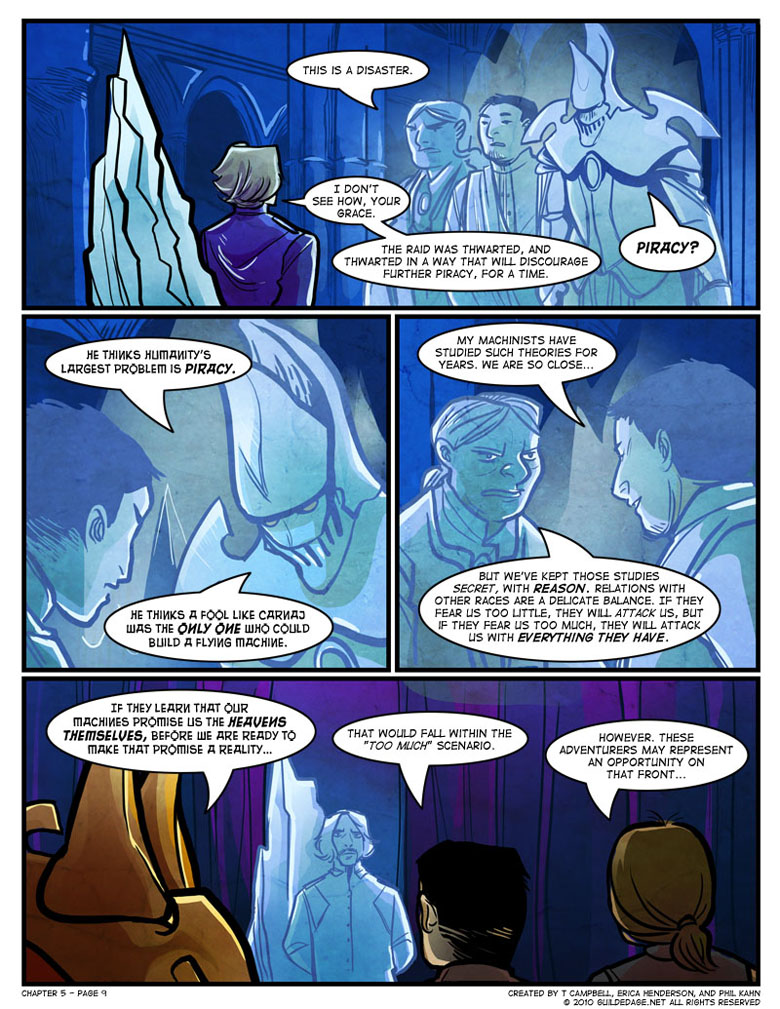Annotated 5-9
 So this scene went through a couple of big revisions. At first, Ardaic was communicating ONLY with Priestlord Gigundus. This reflected my belief that the Bloodshot Eyeball was a more powerful force in Gastonia than it eventually became: that Gastonia might even qualify as a limited theocracy, with the nobles we’d seen in Chapter 3 firmly below “Gigundus” (really Scarlett) in power. (We did know at this point that Gigundus was no longer really Gigundus.) After all, this is a society combining elements of the Middle Ages and the Industrial Revolution, and what was a bigger power in the Middle Ages than the Catholic Church?
So this scene went through a couple of big revisions. At first, Ardaic was communicating ONLY with Priestlord Gigundus. This reflected my belief that the Bloodshot Eyeball was a more powerful force in Gastonia than it eventually became: that Gastonia might even qualify as a limited theocracy, with the nobles we’d seen in Chapter 3 firmly below “Gigundus” (really Scarlett) in power. (We did know at this point that Gigundus was no longer really Gigundus.) After all, this is a society combining elements of the Middle Ages and the Industrial Revolution, and what was a bigger power in the Middle Ages than the Catholic Church?
Phil had a more distributed vision of Gastonia’s political power. He hadn’t yet come up with the Hall of Houses, just individual “Heads” who liked to fraternize, but you can see this scene leaning in that direction. However, it went through more changes after his official revisions, and I think he and Erica figured those out together, with me only giving the nod at the end.
At one point, the third member of this council was going to be not Don Pardo (who’s a bit uncharacteristically grim here) but His Grace Garriott, named for Richard Garriott, aka Lord British and General British, creator of the Ultima series and Tabula Rasa. Garriott’s the one who originally had the line, “My machinists have studied such theories for years,” reflecting his real-life namesake’s fascination with spaceflight. Interesting as that sounds, I think that in a world where houses reflect important industries, it’d be tough to justify Garriott’s focus on a field that doesn’t really exist yet, and the gnomes had already got “machinism” pretty well covered.











I think that should be Miyamoto, not Iwatani.
(tweak tweak tweak) Probably, yeah.
I have a feeling that if this scene had been written with knowledge of the future, they wouldn’t be talking via hologram.
“What is thy bidding my masters…”
Mmm… we shall consult with the toys in the chest today, my delicious pet.
I was thinking the same thing. Is that what the blue light is supposed to convey? If not what was it trying to express?
With hindsight it’s also ironic that Taro played a center role in at least one of the events that lead into the upsetting the balance of power their discussing here that lead into the war down the road and general stuff hitting the fan, given what we learn of him it’s not far off that he probably stole some airship plans and ran off with them to build it so he could have fun playing pirate…kids will be kids, even genius ones with tyrannical leanings.
Basically this was the first in a long chain of dominoes that played out throughout the series.
Am I the only one who thinks Priestlord Gigundus looks a little like Alphonse Elric?
Other than being relatively tall and fully armoured, I don’t see it. The armour design is almost totally different – both are unnecessarily spiky, but the spiky bits are different, and Al’s head doesn’t look like a bishop’s mitre. Also, you know, there’s no question that Al can turn his head. (Gigundus’ helmet looks to be articulated in all but the first panel, but it doesn’t really appear to be useful articulation.)
Add Rie Kugimiya’s voice and I’ll buy it. Actually, I think I’ll just read all his lines in Rie Kugimiya’s voice from now on.
…
He’s so adorable! ^_^
Oh, just about every king and emperor?
Look, I know it is fashionable to see the Middle Ages as some sort of theocracy, but that’s really not true at all. For every Walk to Canossa there are several antipopes to prove this.
I stand by my statement overall, but the Middle Ages lasted a really long time. By the time of “antipopes,” the Church’s authority was on the wane.
The Church never had any secular authority at all. Really. It had tremendous amounts of influence, but the fact that the Walk to Canossa even exists shows that secular authority always asserted itselfic, sometimes succesful, sometimes not.
It is a pervasive myth that the Church was all-powerful. But crack open a decent history book, and the reality is a lot more complex.
And I’m saying this as a mostly agnostic, raised Protestant. I grew up with the old prejudice of the all-powerful Medieval Church.
The Catholic Church’s influence shouldn’t be dismissed. Crusades were fought in the name of the church. And every lord & lady had to at least pay lip service to the church.
The Church had influence, sure.
But to your examples? The First Crusade was a call from the Pope for voluntary service, it was not a commandment. And as an example how well the Pope was heeded, an earlier call for a Crusade against the Moors in Spain was soundly ignored. So there must have been a secular reason why the First Crusade was so popular.
And that lip service? Sure people were religious, but I just gave you an example where that lip service was in fact not paid at all, but the Church roundly put under secular control.
Sorry, but the pervasive myths about the Middle Ages just irritate me.
Here’s a good link as a starter. Note that Tim O’Neill is both an atheist and a historian in the field: https://historyforatheists.com/2016/11/the-dark-ages-popery-periodisation-and-pejoratives/
(I note his atheism to avoid the appearance of a pro-Church bias, often seen in apologists).